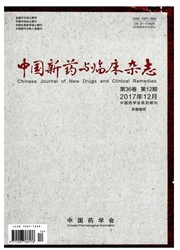

 中文摘要:
中文摘要:
目的观察西那卡塞治疗肾性继发性甲状旁腺功能亢进(SHPT)患者的临床疗效。方法肾性SHPT患者60例分为两组,每组30例。西那卡塞组:西那卡塞起始剂量25mg·d-1,每3周调整一次剂量,最大剂量100mg·d-1;骨化三醇0.25μg,qn。对照组:骨化三醇每次2μg,每周2次,静脉或口服均可。疗程均为6个月。治疗期间每月监测患者血常规和血钙、磷和全段甲状旁腺激素(iPTH)水平,并记录不良反应发生情况。结果西那卡塞组完成28例,对照组患者均完成试验。治疗6个月,西那卡塞组和对照组iPTH达标率分别为82%和37%(P〈0.01),血钙达标率分别为100%和43%(P〈0.01).血磷达标率分别为50%和10%(P〈0.01)。与治疗前比较,西那卡塞组血钙、磷和钙磷乘积均显著降低(P〈0.01),而对照组血钙、磷、钙磷乘积均上升(P〈0.01),组间差异非常显著(P〈0.01)。西那卡塞组和对照组血iPTH均下降(P〈0.01),西那卡塞组下降幅度大于对照组(P〈0.01)。西那卡塞组有1例患者出现消化道症状不良反应,对照组无不良反应发生。结论与骨化三醇冲击疗法相比,西那卡塞降低SHPT患者iPTH水平更明显,同时具有降低血钙、磷、钙磷乘积的作用,且安全性较好。
 英文摘要:
英文摘要:
AIM To observe the clinical effects of cinacalcet in renal secondary hyperparathyroidism. METHODS A total of sixty patients with renal secondary hyperparathyroidism were randomized to cinacalcet group (n = 30) and control group (n = 30). The cinacalce group: the initial dose of cinacalcet was 25 mg. d-1, adjusting the dose every three weeks, and the largest dose was 100 mg·d-1; the dose of calcitriol was 0.25μg·d-1. The control group: the dose of calcitriol was 2 μg each time, twice a week, intravenous injection or oral were all allowed. The courses of two groups were 6 months. The levels of blood calcium, phosphorus, intact parathyroid hormone (iPTH) and blood routine were examined every month and the adverse reactions were recorded. RESULTS Twenty-eight patients of the cinacalcet group completed the trial, and all patients of the control group completed. After 6 months treatment, 82% of the cinacalcet group and 37% of the control group achieved targets in iPTH (P 〈 0.01), 100% and 43% in blood calcium respectively (P 〈 0.01), 50% and 10% in blood phosphorus respectively (P 〈 0.01 ). Compared with those before the treatment, the levels of blood calcium, phosphorus and calcium-phosphorus product were all decreased significantly in the cinacalce group (P 〈 0.01), which were all increased in the control group (P 〈 0.01), with very significant difference between two groups (P 〈 0.01 ). The levels of iPTH were all decreased in both groups (P 〈 0.01 ), and showed greater in the cinacalce group (P 〈 0.01). One patient withdrew from the treatment because of gastrointestinal intolerance in the cinacalcet group. No adverse reactions occurred in the control group. CONCLUSION The effect of cinacalcet in reducing iPTH level is better than calcitriol shock therapy for renal secondary hyperparathyroidism patients. At the same time, cinacalcet can decrease the levels of blood calcium, phosphorus and calcium-phosphorus product, and it is also secure.
 同期刊论文项目
同期刊论文项目
 同项目期刊论文
同项目期刊论文
 期刊信息
期刊信息
